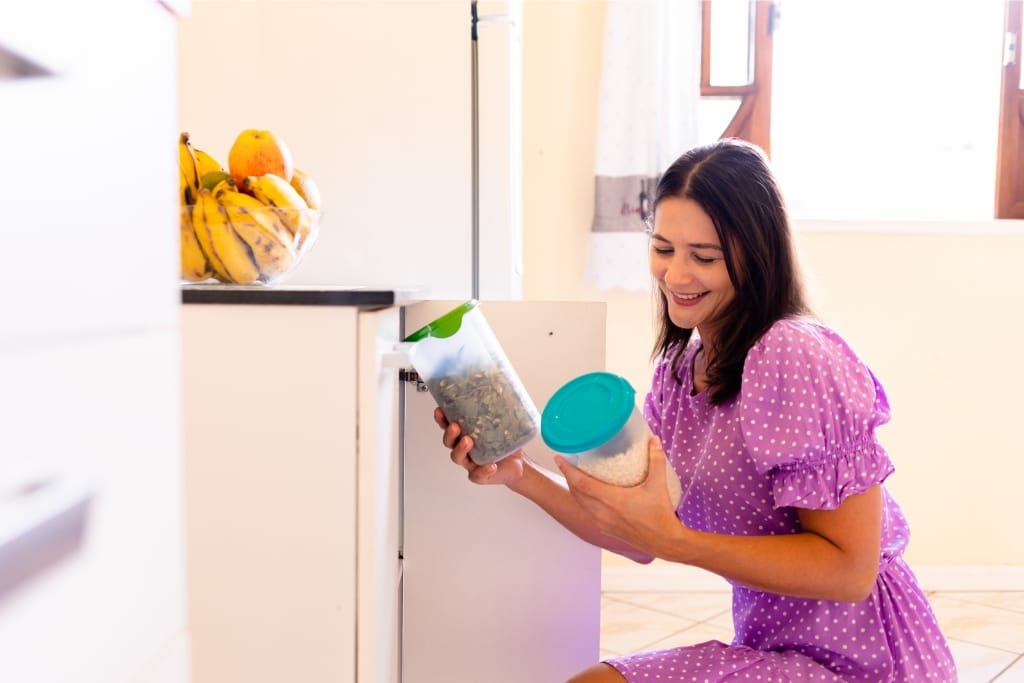A cluttered and disorganized kitchen can turn the joy of cooking into a frustrating experience.
However, with some practical strategies, you can transform chaos into order and create an efficient, enjoyable cooking environment.
By implementing these 10 tips, you’ll streamline your kitchen setup, making it easier to find ingredients and utensils while maximizing your space.
Say goodbye to the stress of clutter and hello to a kitchen that truly works for you and your culinary needs.
1)) Declutter Regularly
The first step to an organized kitchen is to declutter regularly. Go through your pantry, cabinets, and drawers, and remove any items you no longer use or need.
This will free up valuable space and make it easier to find what you're looking for.
Tips for Effective Decluttering:
- Set a Schedule: Commit to decluttering your kitchen at least once every three months. Setting a regular schedule helps ensure you stay on top of clutter before it becomes overwhelming.
- Categorize Items: Sort your items into categories such as utensils, appliances, dry goods, and perishables. This makes it easier to assess what you have and what you can get rid of.
- Use the "One Year Rule": If you haven’t used an item in the past year, consider donating or recycling it. Chances are you don’t need it and it’s only taking up valuable space.
- Create "Keep, Toss, Donate" Piles: As you go through your items, place them in one of these three piles. This approach helps you make quick decisions and see progress more clearly.
- Invest in Storage Solutions: Use baskets, drawer dividers, and clear containers to keep everything neat and visible. Proper storage solutions can prevent clutter from building up again.
By committing to regular decluttering and following these tips, you can maintain a clean and organized kitchen effortlessly.
Consistent effort in decluttering not only frees up space but also creates a more enjoyable and efficient cooking environment.
An organized kitchen is the first step towards a stress-free culinary experience.
2)) Use Storage Containers
Invest in storage containers to help keep your pantry items organized. Label each container with the contents inside to make it easy to find what you need.
Clear containers are ideal as they allow you to see the contents at a glance.
Tips for Effective Use of Storage Containers:
- Choose the Right Sizes: Select containers of various sizes to accommodate different types and quantities of pantry items. This ensures you maximize your space and prevent overcrowding.
- Label Everything: Use labels to identify the contents of each container. This makes it easy to find what you need without having to open every container.
- Opt for Stackable Containers: Stackable containers make the best use of vertical space in your pantry or cabinets, helping to keep everything organized and accessible.
- Use Airtight Containers for Perishables: For items such as flour, sugar, or cereals, use airtight containers to keep them fresh for longer and prevent pests from getting in.
- Group Similar Items Together: Store similar items, like baking supplies or snacks, in the same area. This categorization makes it easier to locate and access your ingredients quickly.
By incorporating storage containers into your kitchen organization routine, you create a more streamlined and efficient space.
Properly labeled and well-chosen containers not only keep your pantry items fresh and accessible but also enhance the overall tidy appearance of your kitchen.
An organized kitchen is key to a smooth and enjoyable cooking experience.
3)) Utilize Vertical Space
Use vertical space in your kitchen by installing shelves or hooks on the walls to store pots, pans, and utensils.
This will free up valuable counter and cabinet space and give your kitchen a more streamlined look.
Tips for Utilizing Vertical Space:
- Install Wall Shelves: Add wall-mounted shelves to store frequently used items or display decorative pieces. This helps to keep your countertops clear and provides easy access to your essentials.
- Use Magnetic Strips: Mount magnetic strips on the wall to hold knives, metal utensils, or even spice jars. This not only saves drawer space but also keeps your tools within arm's reach.
- Hang Pots and Pans: Install sturdy hooks or a pot rack to hang your pots and pans. This method frees up cabinet space and adds a functional, rustic look to your kitchen.
- Vertical Dividers in Cabinets: Use vertical dividers within your cabinets to store baking sheets, cutting boards, and trays. This allows for better organization and easier access without having to sift through stacked items.
- Pegboards for Versatility: Consider installing a pegboard on your kitchen wall. This adaptable solution lets you hang various items like utensils, pots, and cooking tools and can be easily rearranged to suit your needs.
By effectively utilizing vertical space in your kitchen, you can significantly enhance both functionality and aesthetics.
Through the use of wall shelves, magnetic strips, and pegboards, you open up countertop and cabinet areas, making the kitchen feel more spacious and organized.
Making the most of vertical storage solutions not only declutters your kitchen but also ensures that you have everything you need within easy reach, promoting a more efficient and enjoyable cooking experience.
4)) Group Like Items Together
Keep similar items together in your cabinets and drawers to make it easier to find what you need.
For example, store all your baking supplies in one area, all your spices in another, and so on.
Tips for Grouping Like Items Together:
- Designate Specific Zones: Create specific zones or areas within your kitchen for different categories of items, such as baking supplies, spices, or snacks. This helps to streamline your cooking process.
- Use Baskets or Bins: Place items within baskets or bins to keep similar things together. This prevents smaller items from getting lost and keeps your cabinets and drawers neat.
- Label Shelves and Bins: Clearly label the shelves and bins where grouped items are stored. This provides a quick visual cue, making it easy to locate what you need.
- Arrange by Frequency of Use: Store frequently used items in the most accessible locations, and less frequently used items in harder-to-reach places. This optimizes your workflow.
- Consider Clear Containers: Use clear containers or jars for items like grains, legumes, or baking essentials. This not only keeps them organized but also makes it easy to see when you are running low.
By grouping like items together in your kitchen, you create a more organized and efficient cooking environment.
Designating specific zones, labeling shelves and bins, and using clear containers all contribute to a streamlined workflow, saving you time and reducing frustration.
An orderly kitchen not only enhances your cooking experience but also makes meal preparation quicker and more enjoyable.
5)) Create A Meal Planning Station
Designate an area in your kitchen as a meal-planning station where you can keep a calendar, shopping list, cookbooks, and other meal-planning essentials.
This will help you stay organized when planning meals for the week.
Tips for Creating a Meal Planning Station:
- Dedicated Space: Choose a specific area in your kitchen for your meal planning station, such as a corner of the countertop or an unused section of a wall. Having a designated spot ensures all your meal-planning tools are in one place.
- Install a Chalkboard or Whiteboard: Use a chalkboard or whiteboard to jot down your weekly meal plans and shopping list. This visual aid makes it easy to stay on track and adjust plans as needed.
- Keep a Calendar Handy: Hang a calendar nearby to keep track of important dates like grocery shopping days, expiration dates, and meal-prep schedules. A calendar can help you stay organized and avoid last-minute meal scrambles.
- Organize Cookbooks and Recipes: Store your most frequently used cookbooks and recipe cards at the station. Consider using a small shelf or a set of wall-mounted pockets for easy access and organization.
- Utilize Storage Bins: Use small bins or containers to organize pens, sticky notes, scissors, and other meal-planning supplies. Keeping these items neatly stored ensures your station remains clutter-free and functional.
Creating a meal planning station in your kitchen can significantly enhance your meal preparation process.
By dedicating a specific space for meal planning tools, using visual aids like chalkboards or whiteboards, and organizing recipe resources, you streamline your cooking routine and reduce stress.
With a well-structured meal planning station, you can easily manage your weekly menus, stay on top of grocery shopping, and make your kitchen more efficient and enjoyable to use.
6)) Install Drawer Dividers
Drawer dividers are a great way to keep utensils and gadgets neatly organized in your drawers.
They prevent items from shifting around and mixing up, making it easier to quickly find what you need.
Tips for Installing Drawer Dividers:
- Measure Your Drawers: Before purchasing dividers, measure the dimensions of your drawers to ensure you get dividers that fit perfectly. Custom-fit dividers can maximize your drawer space.
- Choose Adjustable Dividers: Opt for adjustable dividers that can be reconfigured as your needs change. This flexibility allows you to accommodate different items over time.
- Categorize Your Items: Group similar items together and assign them specific sections within the drawer. This helps keep everything organized and easy to find.
- Consider Different Materials: Drawer dividers come in various materials like wood, plastic, and metal. Choose a material that suits your kitchen's aesthetics and is easy to clean.
- Label Sections: If you have multiple people using the kitchen, labeling the sections of the drawer dividers can help everyone maintain the organized system.
By installing drawer dividers, you can achieve a heightened level of organization in your kitchen.
Custom-fit and adjustable dividers allow you to make the most of your drawer space, ensuring that utensils, gadgets, and other items remain neatly in place.
Categorizing items and choosing materials that match your kitchen’s décor further enhance functionality and aesthetics.
Properly labeled sections also make it easier for everyone using the kitchen to find and return items to their designated spots, maintaining order and efficiency.
7)) Maximize Cabinet Space
Make the most of your cabinet space by using stackable shelves or risers to create additional storage levels.
This will allow you to store more items without taking up extra space.
Tips for Maximizing Cabinet Space:
- Use Stackable Shelves: Incorporate stackable shelves or risers to create multiple levels within a single cabinet. This maximizes vertical space and allows you to store more items efficiently.
- Install Pull-Out Drawers: Adding pull-out drawers or trays makes it easier to reach items at the back of the cabinet and utilizes the full depth of the space.
- Add Hooks or Racks: Attach hooks or racks to the inside of cabinet doors to hang items like pot lids, measuring cups, or utensils, freeing up shelf space.
- Utilize Corner Cabinets: Corner cabinets often have wasted space; consider installing a lazy Susan or pull-out corner storage units to make these areas more accessible and organized.
- Group Items by Frequency of Use: Store items based on how often you use them. Place frequently used items at eye level or within easy reach, and store less frequently used items higher up or at the back.
By maximizing cabinet space, you can greatly improve the functionality and organization of your kitchen.
Using stackable shelves, pull-out drawers, and hooks for added storage levels and accessibility ensures that every inch of space is utilized efficiently.
Incorporating solutions like lazy Susans for corner cabinets and organizing items by frequency of use further streamline your kitchen operations.
With these tips, you'll create a more practical and clutter-free kitchen environment, making it easier to find and store your items effectively.
8)) Keep Countertops Clear
Cluttered countertops can make your kitchen feel cramped and overwhelming.
Keep countertops clear by only displaying essential items such as appliances that are used regularly.
Tips for Keeping Countertops Clear:
- Store Appliances: Only keep appliances that you use daily on the countertops. Store less frequently used appliances in cabinets or pantry spaces to reduce clutter.
- Use Wall-Mounted Storage: Install wall-mounted hooks, shelves, or magnetic strips for commonly used items like knives, pots, and utensils. This frees up counter space while keeping essentials within reach.
- Designate Zones: Create specific zones on your countertop for different tasks, such as a coffee station or a prep area. Removing non-essential items from these zones can keep them organized and functional.
- Employ Drawer Storage: Utilize drawers to store items that often clutter countertops, such as spices, utensils, and kitchen tools. Drawer dividers can help keep these items organized.
- Regularly Declutter: Make it a habit to clear off countertops regularly. Remove items that don't belong there and do a quick wipe-down to keep the space clean and inviting.
By keeping countertops clear, you can create a more spacious and efficient kitchen environment.
Storing appliances out of sight, utilizing wall-mounted storage, and designating specific zones help maintain an organized and clutter-free space.
Employing drawer storage and regular decluttering ensures that your countertops remain functional and visually appealing.
These practices not only enhance the aesthetics of your kitchen but also make daily tasks more manageable and enjoyable.
9)) Label Everything
Labeling is key to maintaining an organized kitchen. Use labels on shelves, baskets, containers, and jars so everyone in the household knows where things belong.
Tips for Labeling Everything:
- Use Clear Labels: Opt for clear, legible labels that are easy to read. This helps ensure that everyone can quickly find what they need and return items to their designated spots.
- Choose Durable Materials: Select labels made from durable materials that can withstand kitchen conditions, such as waterproof labels for items stored near the sink or stove.
- Color-Code Labels: Consider using different colors for different categories, such as red for baking supplies and blue for cleaning products. This color-coding system can make it even easier to identify items at a glance.
- Label Shelves and Cabinets: Place labels on the edges of shelves and the inside of cabinet doors to indicate where various items should be stored. This guidance is particularly helpful for larger families or shared kitchens.
- Update Regularly: Periodically review and update labels as needed. If your storage system or the contents of your kitchen change, make sure the labels reflect the new organization for continued efficiency.
By labeling everything, you facilitate a more organized and efficient kitchen environment.
Clear and durable labels, potentially color-coded, help ensure that everyone knows where items belong and can easily find them.
Labeling shelves, cabinets, and containers reduces the time spent searching for items and promotes a collaborative effort to maintain order.
Regularly updating labels to reflect any changes in your storage system keeps your kitchen running smoothly.
Embracing these labeling practices leads to a more harmonious and clutter-free kitchen, making everyday tasks more pleasant and manageable.
10)) Clean As You Go
Make it a habit to clean as you go while cooking or baking in the kitchen. Wash dishes as soon as you're done using them, wipe down countertops after preparing meals, and sweep or vacuum floors regularly to keep your kitchen looking neat at all times.
Tips for Cleaning As You Go:
- Prep a Cleaning Station: Set up a cleaning station with essential supplies such as a sponge, dish soap, and a towel within easy reach. This makes it convenient to clean up quickly between tasks.
- Use a Soapy Water Basin: Keep a basin of soapy water in the sink while you cook. As you finish using dishes and utensils, place them in the basin to soak, making them easier to clean later.
- Wipe Surfaces Immediately: Keep a cloth or paper towel handy to wipe down counters and stovetops immediately after spills or food prep. This prevents messes from drying and becoming harder to clean.
- Discard Waste Promptly: Have a small waste bin or compost container nearby to dispose of food scraps, wrappers, and other debris as you go. This keeps your workspace tidy and free from clutter.
- Clean Utensils and Dishes Early: Wash cooking utensils, cutting boards, and dishes as soon as you are done using them. Clean pots and pans while food is cooking to stay ahead of the mess and reduce the final post-meal cleanup time.
By adopting the practice of cleaning as you go, you can significantly reduce the stress and workload associated with post-meal cleanup.
Establishing a convenient cleaning station, using a soapy water basin, and promptly wiping surfaces promote a more organized and efficient kitchen experience.
Discarding waste immediately and cleaning utensils and dishes early help maintain a tidy workspace, making cooking more enjoyable and less overwhelming.
Embracing these habits ensures your kitchen remains clean and welcoming, making daily meal preparation a more pleasant task.
Conclusion
Implementing these 10 tips will transform your kitchen into a well-organized and efficient space.
From utilizing drawer storage and labeling everything to cleaning as you go, each strategy contributes to reducing clutter and enhancing functionality.
Maintaining an organized kitchen requires ongoing effort, so take the time to regularly declutter, update labels, and clean up promptly.
By adopting these practices, you’ll not only create a more visually appealing kitchen but also streamline your cooking process, making meal preparation more enjoyable and less stressful.
With dedication and consistency, you'll cultivate a kitchen environment that's both practical and inviting, ensuring a pleasant cooking experience for years to come.
Download Our Free E-book!







